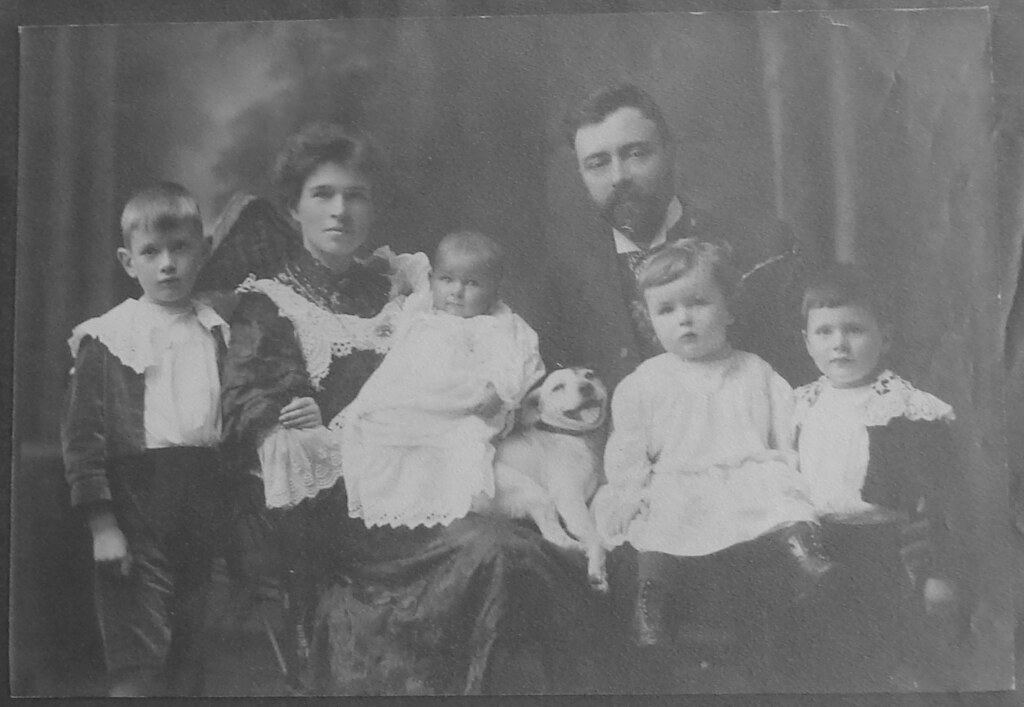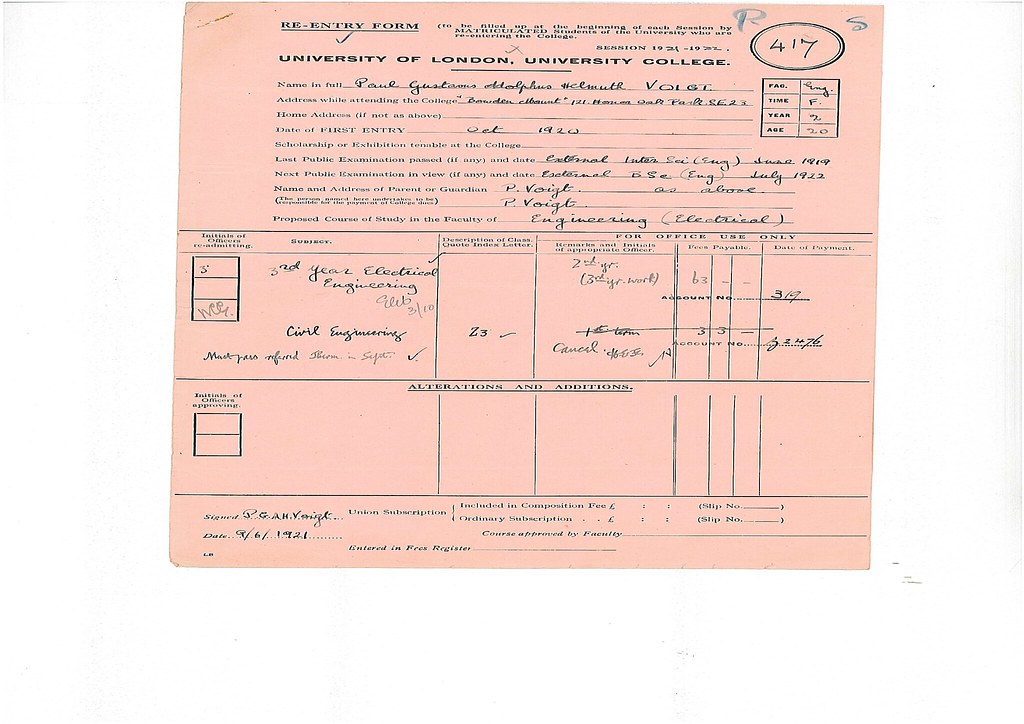
Meanwhile, all these people are remembered as the fathers of an electrodynamic loudspeaker, while the person who provoked the interest of audio producers in the speakers and made this type really popular in the 1920s and 1950s remained in the shadows. This name is Paul Voight. His patent application in Britain for an electrodynamic loudspeaker was filed only a few weeks later than that of Rice and Kellogg. In addition to the speakers, his merits are the original labyrinth and horn structures of the speaker systems. It is believed that thanks to his efforts, broadband speakers, crossovers and coaxial diffusers began to be widely used ... Resurrecting the Personality and Sound cycle, we talk about Paul Voight.
Beginning of the path, education, family
Paul GAH Voigt was born December 9, 1901 in London, where his parents lived. He resided at Boudon Mount, 121 Honor Oak Park. Paul's parents were from Elberfeld in Wuppertal, Germany. Mother was Emmy Peters (1871-1974), father - Paul Voight (senior) (1867-1937). Emmy was from a very wealthy family who owned a large factory for the production of clothing and hats. Paul Sr. and Emmy got married in 1900 and immediately moved to London, where they received British citizenship.

Emmy Peters and Paul Voight (Sr.) with their sons in London (presumably 1902
Paul Sr. joined his wife's family business and founded Peters-Voigt in London as a subsidiary of a German company. The main goal was to develop hat sales in the UK. Judging by the fact that Paul (the younger one) was able to get an education at Dalwich College and University College in London, it can be said with certainty that the Voight family was very well-off.

Otherwise, for 2 prestigious universities at that time, banal, there would not be enough money. It is known that at Voight College, London settled on a Bachelor of Electrical Engineering degree, completing his studies in 1922. In the same year, he settles in Edison Bell, in Peckham.

British Record Revolution
Almost immediately Voight manifests himself as a talented inventor and receives many patents for inventions every year. At that time, Edison Bell was a leading British company for the production of phonographs and records. The company also develops the production of radios.

Voight is working hard and creating a more efficient way of recording, significantly increasing the fidelity of playing phonograph records. He drew attention to the recording methods and grooving technology used by the British Broadcasting Company, and was able to repeat their recording method with high precision musical modulation.

Voight was one of the first to propose an electromechanical recording method, for which he developed a special cutter with a moving coil and a feedback circuit. Thanks to the electromechanical recording device, Edibell label, owned by Edison Bell, was for some time considered the best in Britain, and possibly the best in the world.

Voight design radio at work time at Edison Bell
Edison Bell created a special recording division that was commissioned in the best concert halls in Europe. He was personally led by Voight, as the author of the sound recording method. In 1927, Voight spent a long time with the team in Zagreb, where he recorded more than 600 albums.
Developments at Edison Bell and the Late Patent Application
Even before the moment when Edison Bell ceased to exist, Voight was working for the company, and this had a reason. Under the terms of the contract, in the event of withdrawal or termination of activity, Voight received 19 of his patents, which were previously used by his employer.
Edison Bell was pushed into the market by more powerful competitors, but despite this, the company continued to support the talented Voight. He had the opportunity to continue experiments, in particular, to develop new radios, microphones, recording devices, tube amplifiers, transformers, pickups, and most importantly, what became his legacy - speakers and loudspeakers for them.

One of Voight's earliest speakers
As I noted above, his British patent application number 238310 for a dynamic moving-coil speaker was filed May 20, 1924, i.e. just a month and a half after the application for a similar device was registered in the United States (March 27, 1924).
New devices and mic failure on the BBC
Edison Bell was closed in 1933 due to takeover. Voight, becoming the owner of the right to use 19 of his patents, opened his own company Voigt Patents Ltd in Sydenham. Back in the 1920s, he married and lived with his wife Ida in Spring Grove House, 56 Church Road, in Upper Norwood. A happy marriage and an excellent view from the window, which he found similar to the one that he had seen from the window of the parental home, clearly contributed to his creative activity.

He continued to work in Britain until the end of World War II. From the mid-thirties to 1945, he received another 13 patents. The basis of his company's earnings were horn loudspeakers for movie theaters. He also experimented, creating promising speakers, microphones and various devices for studio recording.

It should be noted that the Vojta company at that time was a workshop-laboratory and small production, and most of the devices were small-scale, but in terms of fidelity of reproduction (recording, capture) they surpassed the vast majority of analogues. A little later, Paul Voight met with O. Lawter, the owner of Lowther Manufacturing Company. They join forces and, when their companies merge, Lowther-Voigt Radio appears, which can create relatively massive products.

Not without failures. One of Voight’s microphone models was used on the BBC. An excellent condenser microphone for its time made it possible to transmit the entire frequency range of human speech and distorted it less than devices of other companies.

However, the susceptibility to humidity became a drawback of the model, which in turn led to frequent failures, since he worked in a damp, freshly built “broadcast house” in the center of the British capital. Voight redesigned the design, and as a result, the BBC was satisfied with its development, Voight microphones were used there until the early fifties.
Speakers & Loudspeakers
Voit’s inventive contribution to the creation of speakers and speakers is considered especially great. Back in the late twenties, he began work on creating a broadband loudspeaker, and in 1933 the first prototypes of Wojt's broadband double-diffuser speaker with a mechanical crossover, which in the British technical literature of that time was called a wiser, appeared.

The device possessed fidelity of reproduction unthinkable for that time. Thanks to the additional RF diffuser, the upper limit of the frequency range reached 14–16 kHz, which was even excessive for the recording capabilities of that time. Enthusiasts still buy these speakers, considering their parameters to be among the best in history.
The main problem with the development of speakers at that time was the lack of powerful permanent magnets. In the first speakers, incl. Vojta, instead of constant electromagnets were installed. Later, the materials needed to create powerful permanent magnets were needed by the front, which to some extent pushed the creation of fundamentally new GGs. Meanwhile, Voight managed to achieve a flux density of 18,000 Gauss (1.8 Tesla).

It is also known that Voight proposed acoustics with a translation line and was one of the first to describe the theory of sound propagation in such a system. Perhaps he was the first who appreciated all the shortcomings of classical horns when using dynamic speakers and began to look for an alternative. So the first version of the transmission line appeared, later called the Voight pipe, today better known as TQWT.
The peak of Voight's achievements in the development of acoustic design was the highest form of evolution of horns, the so-called Inner Corner Shout of Voight. To date, many appreciate this type of acoustic design and consider it one of the best options for hi-fi speakers. The first prototype of this device appeared in 1934 and in the same year it was brought to the series by the efforts of the freshly created Lowther-Voigt Radio.

Today, this acoustics seems overly complex, but many of those who design acoustic systems note its unique features, such as diffuse sound, with the so-called. “Disappearance of the real source”, as well as the ability to transmit the midrange realistically with minimal distortion.

various options for an internal corner horn
Many of Voight’s proposed solutions seem like monstrous archaic. But, evaluating Voight’s contribution, one must take into account that at the time when he introduced his developments, monstrous-sounding inductor loudspeakers in horns and wheezing “plates” were still used everywhere.
Sticks on wheels and wartime adversity
With the outbreak of war, Voight began to feel the hostile attitude of the British authorities. His German origin (despite British citizenship) was constantly causing problems. So for this reason, he was forbidden to participate in significant state research programs. Meanwhile, contemporaries, including Angier from Decca and Blumlein from EMI, noted that discussions with Voigt at the Institute of Electrical Engineering were extremely useful.
Another problem seriously hindered Voight's work during the war, a ban on the development and testing of speakers. The whistling test signals used by Voigt, according to authorities, could be mistaken for a raid by German aircraft. Voight had to work in almost complete silence.
When the war ended, Voight was confronted with an acute shortage of cement, gypsum, and wood, which were essential in creating his speakers. He was often refused materials due to his nationality. Also, according to rumors, it was his German surname that caused the refusal of materials for the repair of his house, which suffered from the bombing. Having suffered enough from the British post-war Germanophobia, Voight seriously thought about emigration.

Paul Voight and his wife in Canada (50s)
The post-war period required a quick recovery of the country, which Hitler aviation (and even a little rocket) had long ironed. This did not imply a rapid increase in wealth and, of course, only a few could afford to buy powerful speakers and a radio.

“Inner corner horn licensed in the 50s”
All this, as well as a prejudice towards his nationality, made Voight go to Canada. Lauter, who remained in Britain, continued to produce speakers with the design of “Inner Corner Shout”, licensed by Voight. The latter allowed Paul to live relatively comfortably in Canada.
Total
The biography of Paul Voight reminded me of the story of Fritz Sennheiser and his company. In fact, Voight in the 1920s and 1930s made a contribution to the development of electroacoustics and sound engineering comparable to that which Sennheiser had already made after the Second World War. Perhaps nationality also worked associatively. One way or another, in my opinion, Voight is an unjustly forgotten pioneer of electroacoustics, and I hope my material will partially correct this injustice.

One of the last photos of the inventor with his wife (presumably 1980
Paul Voight died on February 9, 1981, leaving as an inheritance his inventions and patents (a total of 32 copyright certificates). Many prominent audio engineers honored his memory with capacious obituaries. So the most respected audio expert, engineer Geoffrey L. Wilson published the dedication of the bright memory of the inventor in the Audio Engineering Society. Paul Klipsch also praised Voight's contribution as one of the significant, but forgotten pioneers in audio.
Traditional advertising
We sell speakers , in our catalog , unfortunately, there is nothing produced by Paul Voight and his companies, a wide range of other speakers and other high-fidelity audio equipment is presented.
The material used photo content:
lowtherloudspeakers.com/lowther-history
www.lowthervoigtmuseum.org.uk
www.roger-russell.com
pinkfishmedia.net/forum/threads/pgah-voigt-a-great-audio-inventor.78278/page-2